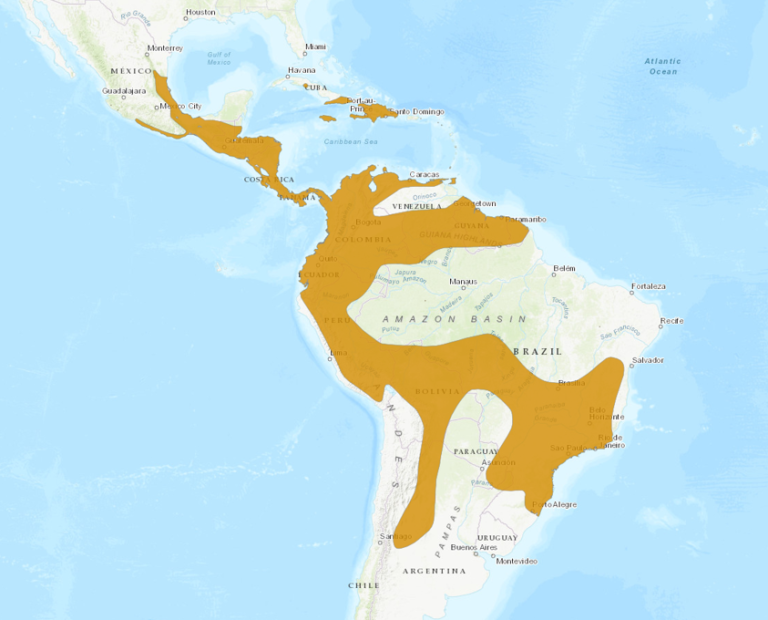Birdfinding.info ⇒ The most widespread, numerous, conspicuous, and readily identifiable swift throughout most of the Neotropics. Especially common from Veracruz and Oaxaca, Mexico, south through Central America and the tropical Andes to central Bolivia, and separately in southeastern Brazil. More localized in the West Indies, where it most readily found on Jamaica and around Cuba’s Topes de Collantes National Park.
White-collared Swift
Streptoprocne zonaris
Neotropics from Mexico and the West Indies to Argentina.
Breeds colonially in caves or behind waterfalls, mostly in mountains and foothills, over a wide altitudinal range: from near sea level up to at least 4,200 in the equatorial Andes. Disperses widely over lowlands when not breeding.
In the West Indies, resident on Cuba, Jamaica, and Hispaniola; and a seasonal visitor to Trinidad (mainly July to October, but smaller numbers arriving in May and departing in February).
In Middle America, it occurs from coastal plains up to around 2,500 m elevation from Nayarit and southern Tamaulipas south through Panama.
In South America, widely distributed throughout the tropical and subtropical mountains and hill country of the north, west, and southeast, but sparse in the interior and northeast.
In the Andes, present nearly throughout: on the Pacific slope south to southern Peru, and in the interior and eastern flanks south to central Bolivia and discontinuously south to central Chile (Maule) central Argentina (to Mendoza, San Luis, and Córdoba).
East of the Andes, widespread north of the Amazon Basin in and around the coastal ranges, tepuis, and hill country east to Guyana. South and east of Amazonia, there are large populations across eastern Brazil from Bahia to Rio Grande do Sul and west to Mato Grosso, Paraguay, and northern Argentina (Misiones).
A somewhat regular vagrant outside of its normal Caribbean range, with records from: Aruba, Barbados, Bonaire, Grenada, Guadeloupe, Martinique, Puerto Rico, Saba, St. Kitts, Tobago, and Vieques. As of 2020, it had been recorded north of Mexico at least ten times: mostly along the Gulf Coast in Texas and east to Florida, and once each in California, Michigan, and Ontario, Canada (Rondeau Provincial Park, June 10, 2002).

Brazilian records from © WikiAves 2020
Identification
Distinctive: a very large, blackish-brown swift with a full white neck-collar and a deeply notched tail

White-collared Swift. (Guatapará, São Paulo, Brazil; July 21, 2018.) © Luiz Frare
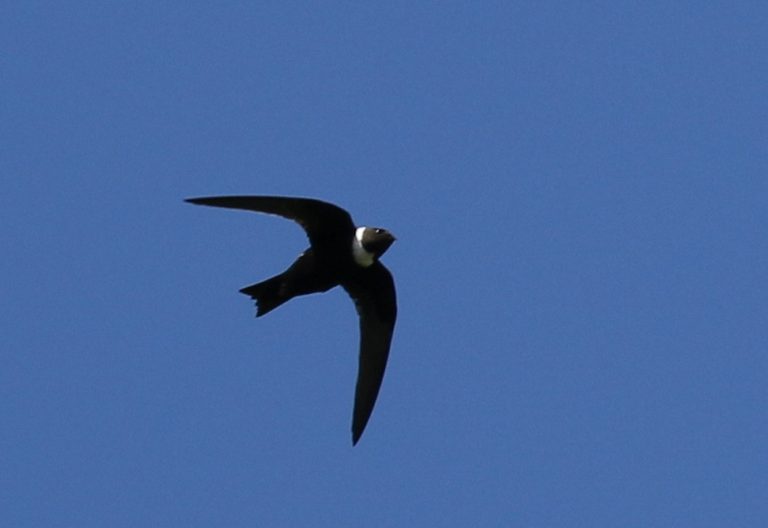
White-collared Swift. (Martha Brae, Jamaica; January 27, 2019.) © Matthew Grube

White-collared Swift, dorsal view. (Praia das Palmeiras, São Paulo, Brazil; May 13, 2013.) © Marcos Eugênio

White-collared Swift. (Paraíso Perdido, Minas Gerais, Brazil; May 11, 2019.) © Giovan Alex

White-collared Swift. (Archidona Canton, Ecuador; February 8, 2019.) © Carol Kwok

White-collared Swift. (Laguna de Mica, Antisana Reserve, Napo, Ecuador; February 20, 2016.) © Jay McGowan

White-collared Swift. (Boliche, Cotopaxi, Ecuador; August 27, 2019.) © Christiana Fattorelli
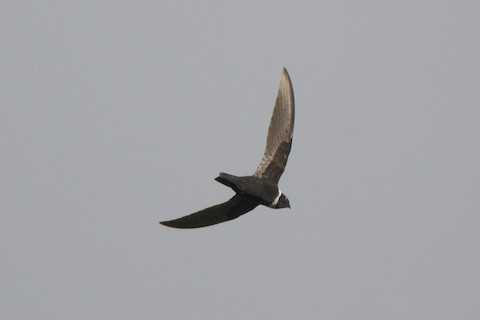
White-collared Swift. (Pueblo Nuevo Lagoon, Heredia, Costa Rica; March 22, 2017.) © Cory Gregory
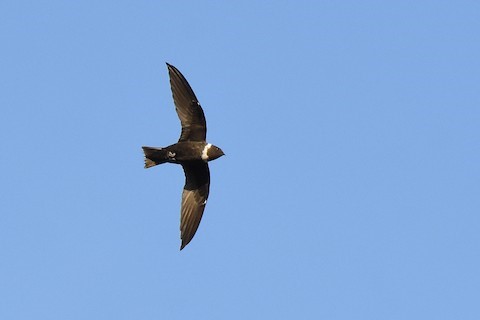
White-collared Swift. (Paquetá, Santa Catarina, Brazil; April 29, 2020.) © Guilherme Willrich

White-collared Swift with wings and tail fully fanned out. (Cosanga, Napo, Ecuador; August 16, 2017.) © Matthew Grube

White-collared Swift. (Manu, Madre de Dios, Peru; June 22, 2014.) © João Quental

White-collared Swift. (Morro do Lampião, Santa Catarina, Brazil; April 1, 2019.) © Fernando Farias
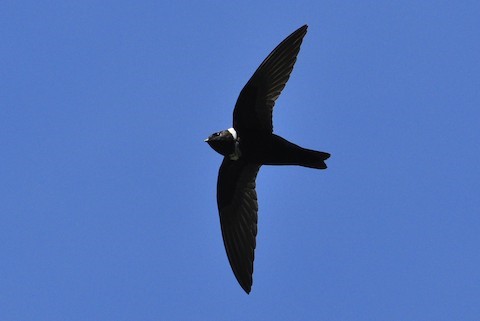
White-collared Swift. (Virgen del Socorro, Alajuela, Costa Rica; December 31, 2012.) © Steve Tucker
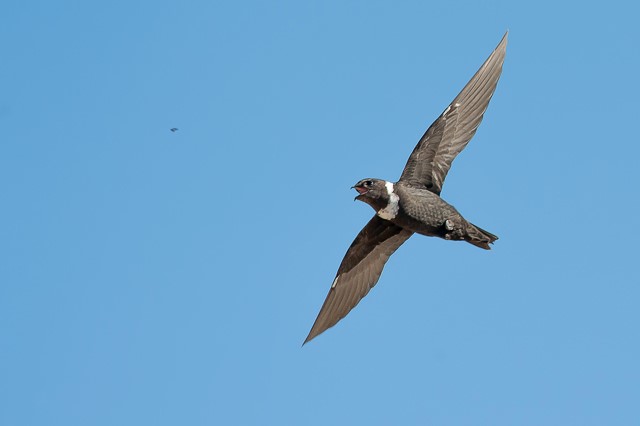
White-collared Swift with mouth open while hunting. (Cidreira, Rio Grande do Sul, Brazil; April 20, 2013.) © Paulo Fenalti
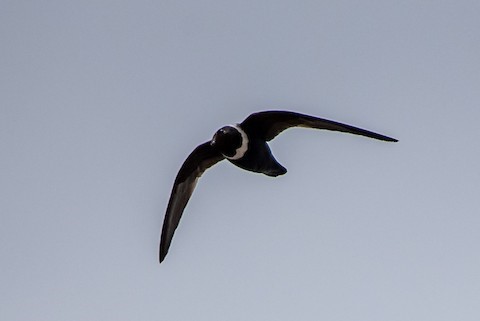
White-collared Swift. (Saltos del Maule, San Clemente, Maule, Chile; January 13, 2018.) © Darío de la Fuente

White-collared Swift. (Hummingbird Highway, Belize; March 8, 2016.) © David Sarkozi

White-collared Swift. (Rio Villa, Antioquia, Colombia; May 5, 2018.) © John Jairo Betancur Salinas

White-collared Swift, head-on. (Morro da Mesa, São Sebastião do Paraíso, Minas Gerais, Brazil; September 24, 2016.) © Aline Patricia Horikawa

White-collared Swift. (Filas de Montemayor, Carabobo, Venezuela; September 1, 2012.) © Héctor José Sánchez Herrera

White-collared Swift. (Iguazú National Park, Misiones, Argentina; September 6, 2017.) © Meg Barron
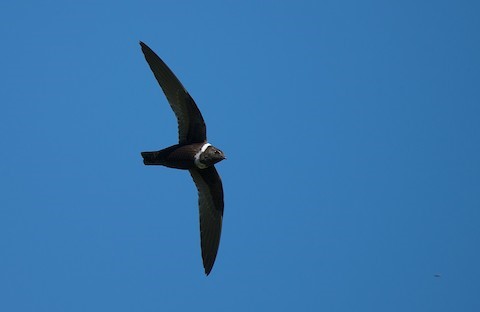
Yellow-fronted Canary, C. m. barbatus, showing essentially all-yellow plumage. (Gambela, Ethiopia; March 24, 2018.) © Joshua Smoulders
Immatures may have either indistinct, incomplete, or otherwise atypical collars. In most cases, these birds will occur alongside typically-collared adults.

White-collared Swift, immature with incomplete collar (on nape only). (Finca La Gracia, Escuintla, Guatemala; May 7, 2019.) © Grete Pasch
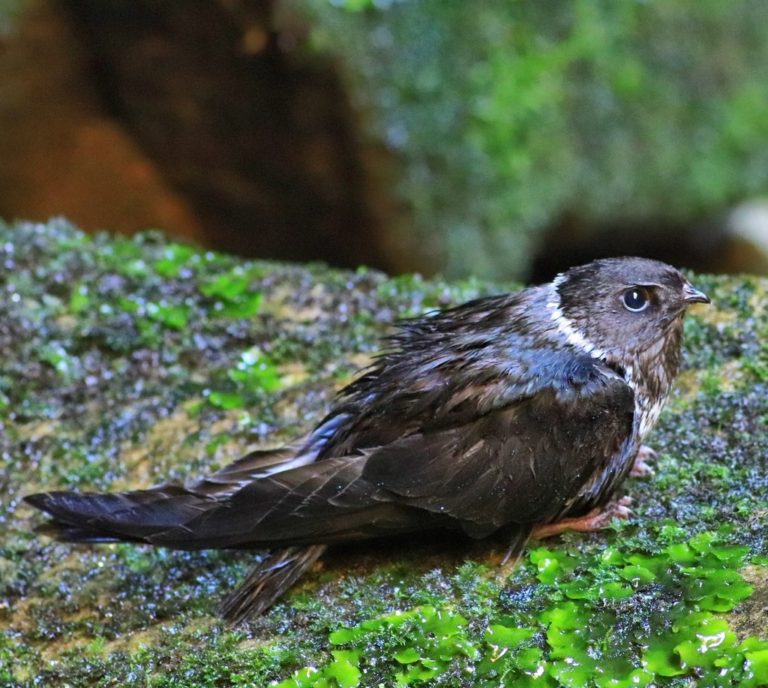
White-collared Swift perched beside waterfall. (Ponta Grossa, Paraná, Brazil; January 10, 2019.) © lrech
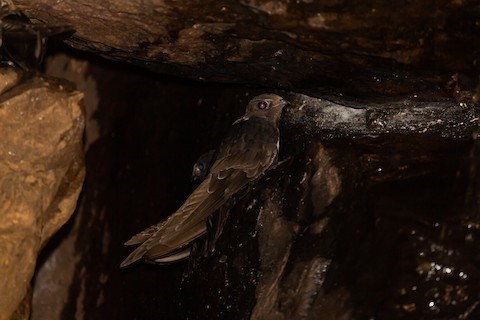
White-collared Swift, perched in a cave, with white collar mostly concealed. (Lago Colbún, San Clemente, Maule, Chile; March 9, 2020.) © Miguel Tapia del Rio

White-collared Swift, perched on cave wall. (Jardín, Antioquia, Colombia; March 3, 2019.) © Sebastian Serna Muñoz
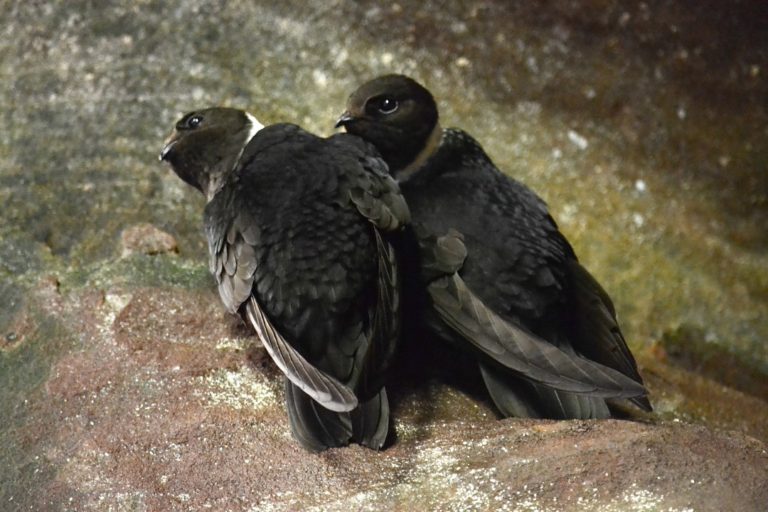
White-collared Swifts. (Rolante, Rio Grande do Sul, Brazil; October 12, 2019.) © Alexandre Picoli

White-collared Swift. (Guaraú, São Paulo, Brazil; November 25, 2017.) © Alexandre Gualhanone
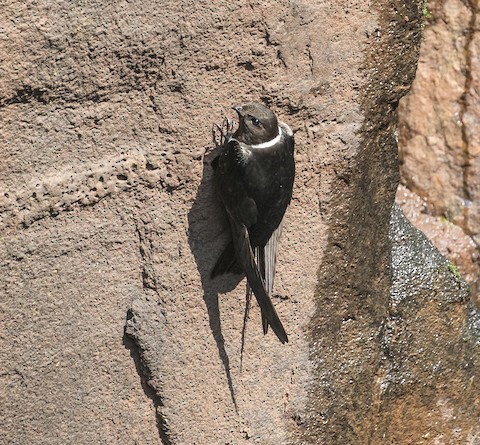
White-collared Swift. (Iguazú National Park, Misiones, Argentina; September 6, 2017.) © Meg Barron
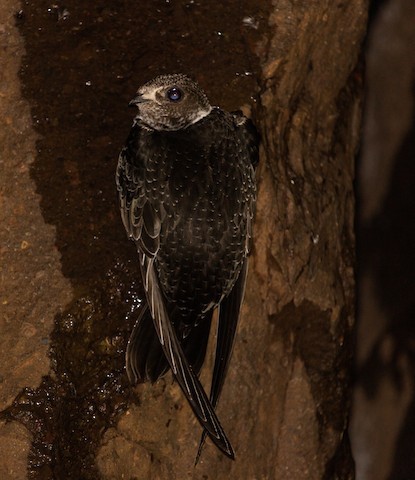
White-collared Swift, showing fine white dots on fresh feathers. (Lago Colbún, San Clemente, Maule, Chile; March 9, 2020.) © Miguel Tapia del Rio

White-collared Swift, on nest in cave. (Jardín, Antioquia, Colombia; March 3, 2019.) © Sebastian Serna Muñoz

White-collared Swifts in cave roost. (Achiras, Córdoba, Argentina; November 3, 2018.) © Franco Mazzucco

White-collared Swifts in cave roost. (Lago Colbún, San Clemente, Maule, Chile; March 9, 2020.) © Miguel Tapia del Rio
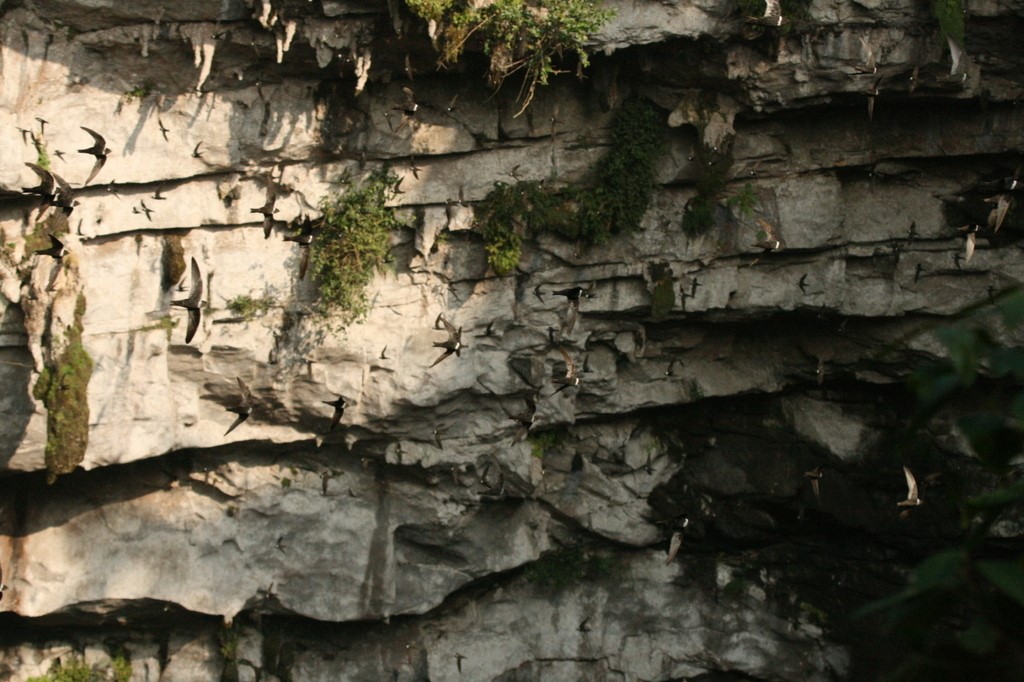
White-collared Swifts at nesting colony site. (Sótano de las Golondrinas, San Rafael Tamápatz, San Luis Potosí, Mexico; August 1, 2014.) © Alfonso Gutiérrez Aldana
Cf. White-naped Swift. In southwestern and central Mexico, and possibly farther east, White-collared and White-naped Swifts overlap. In their typical plumages, they differ obviously in the extent of white around the neck: a full collar versus a thin sliver across the nape. However, immature White-collared sometimes has a reduced collar that is limited to the nape.
Immatures are usually in the company of adults, but White-naped would also join such flocks so this clue has limited diagnostic value. More reliable distinctions are size and tail shape: White-naped is about an inch longer, with proportionately longer wings, and has a squarer tail—sometimes weakly forked or indented in profile, not deeply notched as on White-collared.
Cf. Biscutate Swift. Across large portions of central and eastern Brazil and into Paraguay and northern Argentina, White-collared and Biscutate Swifts overlap. At a distance or in suboptimal viewing conditions they appear extremely similar. If seen clearly, their white collars are usually distinguishable: White-collared’s is complete and broadens up onto the throat, whereas Biscutate’s has a small gap on the side of the neck and the white area broadens down onto the chest. Tail shape also differs: Biscutate generally shows a squarish or rounded tail, not deeply notched as on White-collared.
Notes
Polytypic species consisting of nine recognized subspecies.
References
Alderfer, J., and J.L. Dunn. 2014. National Geographic Complete Birds of North America (Second Edition). National Geographic Society, Washington, D.C.
Ascanio, D., G.A. Rodriguez, and R. Restall. 2017. Birds of Venezuela. Christopher Helm, London.
BirdLife International. 2018. Streptoprocne zonaris. The IUCN Red List of Threatened Species 2018: e.T22686476A130106561. https://dx.doi.org/10.2305/IUCN.UK.2018-2.RLTS.T22686476A130106561.en. (Accessed September 15, 2020.)
Chantler, P. 2000. Swifts: A Guide to the Swifts and Treeswifts of the World (Second Edition). Yale University Press.
de la Peña, M.R., and M. Rumboll. 1998. Birds of Southern South America and Antarctica. Princeton University Press.
eBird. 2020. eBird: An online database of bird distribution and abundance. Cornell Lab of Ornithology, Ithaca, N.Y. http://www.ebird.org. (Accessed September 15, 2020.)
Fagan, J., and O. Komar. 2016. Peterson Field Guide to the Birds of Northern Central America. Houghton Mifflin Harcourt, New York.
ffrench, R. 2012. A Guide to the Birds of Trinidad & Tobago (Third Edition). Cornell University Press. Ithaca, N.Y.
Garrigues, R., and R. Dean. 2014. The Birds of Costa Rica: A Field Guide (Second Edition). Cornell University Press.
Haynes-Sutton, A., A. Downer, R. Sutton, and Y.-J. Rey-Millet. 1986. A Photographic Guide to the Birds of Jamaica. Princeton University Press.
Howell, S.N.G., I. Lewington, and W. Russell. 2014. Rare Birds of North America. Princeton University Press.
Howell, S.N.G., and S. Webb. 1995. A Guide to the Birds of Mexico and Northern Central America. Oxford University Press.
Kirwan, G.M., A. Levesque, M. Oberle, and C.J. Sharpe. 2019. Birds of the West Indies. Lynx Edicions, Barcelona.
Latta, S., C. Rimmer, A. Keith, J. Wiley, H. Raffaele, K. McFarland, and E. Fernandez. 2006. Birds of the Dominican Republic and Haiti. Princeton University Press.
McMullan, M., and T. Donegan. 2014, Field Guide to the Birds of Colombia (Second Edition). Fundación Proaves de Colombia, Bogotá.
Raffaele, H., J. Wiley, O. Garrido, A. Keith, and J. Raffaele. 1998. A Guide to the Birds of the West Indies. Princeton University Press, Princeton, N.J.
Ridgely, R.S., and P.J. Greenfield. 2001. The Birds of Ecuador, Volume II: Field Guide. Cornell University Press.
Ridgely, R.S., and J.A. Gwynne. 1989. A Guide to the Birds of Panama (Second Edition). Princeton University Press.
Schulenberg, T.S., D.F. Stotz, D.F. Lane, J.P. O’Neill, and T.A. Parker. 2007. Birds of Peru. Princeton University Press.
van Perlo, B. 2009. A Field Guide to the Birds of Brazil. Oxford University Press.
Wikiaves. 2020. Taperuçu-de-coleira-branca, https://www.wikiaves.com.br/wiki/taperucu-de-coleira-branca. (Accessed September 15, 2020.)
Xeno-Canto. 2020. White-collared Swift – Streptoprocne zonaris. https://www.xeno-canto.org/species/Streptoprocne-zonaris. (Accessed September 15, 2020.)

